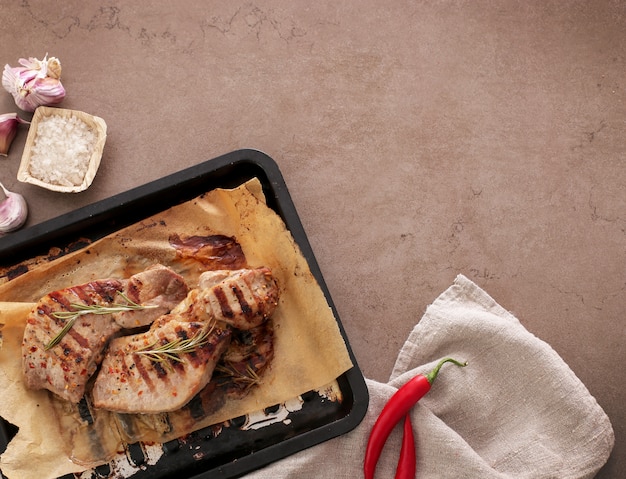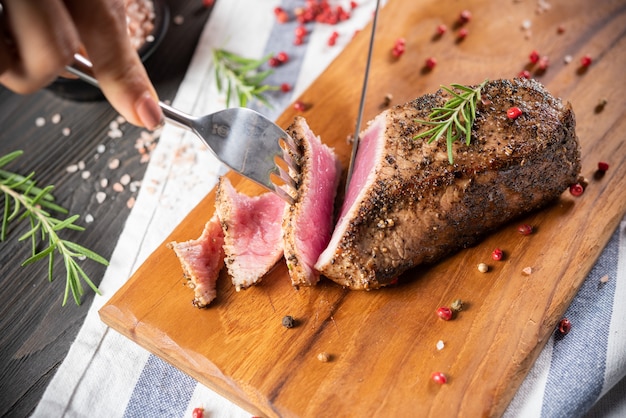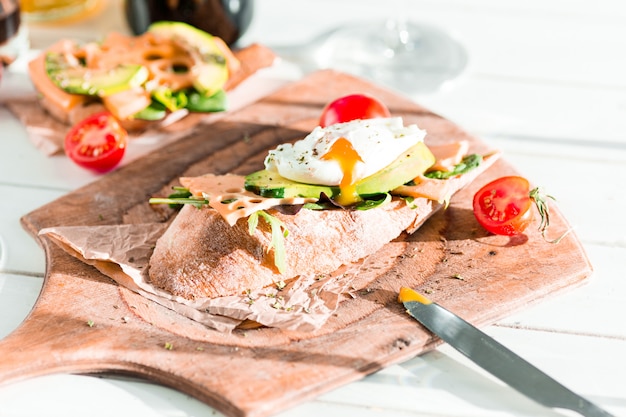Let's be honest, there's nothing quite like a perfectly cooked tuna steak. It's juicy, tender, and bursting with flavor. But let's face it, achieving that "wow" factor at home can feel a little daunting. You're staring at a raw piece of fish and wondering, "How do I avoid dry, overcooked tuna?" Fear not, my friends! We're about to embark on a journey to uncover the secrets of baking the most delicious tuna steaks you've ever tasted. This isn't just a recipe, it's a complete guide, packed with tips, tricks, and insider information.
Part 1: Choosing the Star of the Show - Your Tuna Steak

The first step, and perhaps the most important, is selecting the right tuna. Think of it as casting the lead role in a culinary drama. You want a tuna that's going to steal the show. And trust me, not all tuna is created equal. You'll want to pick a steak that's thick and firm, with a rich, deep red color. Look for labels like "wild-caught" or "line-caught," which tell you that the fish was caught in a sustainable way. This means they're likely to be healthier and tastier.
The Ahi Advantage
If you're feeling fancy, consider treating yourself to "ahi tuna," a premium type of tuna from Hawaii. It's known for its buttery texture and intensely flavorful flesh. But even if you opt for a regular tuna steak, make sure it's fresh. Avoid any tuna that smells fishy or has a grey or brown color. You want that beautiful red hue that practically sings, "Eat me!"
Part 2: Prepping for Success

Now that you've got your star, it's time to prepare for the big performance. Give your tuna steak a good rinse under cold water, and then pat it dry with kitchen paper. You want to remove any excess moisture that could hinder the baking process.
Seasoning Secrets: Flavor Power!
Here's where the fun starts. The way you season your tuna steak is key to unlocking its true potential. A simple salt and pepper pairing will always do the trick, but let's get creative! You can experiment with a variety of herbs and spices, or try a citrus rub for a refreshing zing. Personally, I'm a sucker for a smoky flavor profile. I like to use a blend of smoked paprika, oregano, garlic powder, and black pepper. It adds a depth and complexity that's truly addictive.
Part 3: The Baking Basics

Now, the anticipation is building! Grab a baking tray and line it with parchment paper. This will help prevent sticking and makes for a much easier cleanup. Place your carefully seasoned tuna steak on the tray.
Time and Temperature: The Perfect Duo
The key to baking tuna is to cook it quickly at a high temperature. Preheat your oven to 400°F (200°C). You want to bake the tuna for about 6-8 minutes per side, depending on its thickness. Don't worry, we'll talk about checking for doneness in a bit.
Part 4: Mastering the Art of Doneness
Now, here's where things get a little technical. We want to achieve that perfect balance: cooked through, but still juicy and tender. This is where a trusty meat thermometer comes in handy. For medium-rare tuna, the internal temperature should reach 125°F (52°C).
Visual Clues for the Less-Thermometer-Inclined
If you're not a thermometer fan (no judgment here!), you can use your eyes to judge doneness. As the tuna cooks, its color will change from a deep red to a lovely pink hue. The flesh will also become firm to the touch, but not too hard.
Part 5: Rest and Relaxation for the Star
Once your tuna is cooked, take it out of the oven and let it rest for about 5 minutes before slicing. This allows the juices to redistribute throughout the steak, creating an even more tender and flavorful bite.
The Art of Slicing: A Touch of Precision
Now, grab your sharpest knife and get ready for the final step. When slicing your tuna, you want to cut against the grain. This helps to break down the muscle fibers, making it easier to chew and preventing the steak from falling apart. Aim for even slices, showcasing the beautiful color and texture of your masterpiece.
Part 6: A Feast for the Senses: Serving Suggestions
The moment of truth has arrived! It's time to enjoy your perfectly baked tuna steak. The possibilities for serving are endless, but here are a few ideas to get your culinary juices flowing.
Classic Combinations
- Simple Elegance: Serve your tuna with a fresh green salad and some crusty bread. A drizzle of olive oil and a squeeze of lemon juice elevate the flavors to new heights.
- Asian Flair: For a taste of the East, pair your tuna with rice, edamame beans, and a light soy sauce glaze. The contrasting textures and flavors are truly delightful.
- Mediterranean Delight: Embrace the flavors of the sun with roasted vegetables, a tangy lemon-tahini dressing, and crumbled feta cheese. It's a symphony of fresh, vibrant flavors.
Part 7: FAQs: Addressing Your Burning Questions
Now, let's address those burning questions you might have about baking tuna.
FAQs
| Question | Answer |
|---|---|
| Can I bake tuna in foil? | Yes, you can, but make sure to wrap it tightly to prevent it from drying out. You'll need to cook it for a slightly longer time, as the foil traps the heat. |
| Can I bake tuna with other ingredients? | Absolutely! You can bake tuna with vegetables, like asparagus, cherry tomatoes, or onions. You can even add herbs or spices directly to the baking tray for a burst of flavor. |
| How long can I store leftover tuna? | You can store leftover tuna in the refrigerator for up to 3 days. Make sure to wrap it tightly in plastic wrap or aluminum foil to keep it fresh. |
| Can I freeze tuna before baking it? | It's generally not recommended to freeze tuna before baking, as this can affect its texture and flavor. However, if you must freeze it, wrap it tightly in plastic wrap or aluminum foil. |
| Can I bake tuna in a skillet? | While you can technically bake tuna in a skillet, it's not the ideal method. Baking in the oven ensures even cooking and prevents the tuna from sticking to the pan. |
Part 8: The Grand Finale: A Celebration of Flavor
There you have it, my friends! Armed with this knowledge, you're ready to conquer the world of oven-baked tuna. With a little practice, you'll be creating restaurant-worthy tuna steaks right in your own kitchen. Remember, the key is choosing fresh, high-quality tuna, mastering the art of seasoning, and understanding the importance of doneness. And most importantly, have fun! Experiment with different seasonings and serving suggestions, and discover your own signature way to bake tuna. Happy cooking!
Everyone is watching

Corn on the Cob: The Ultimate Guide to Perfectly Cooked Ears
Healthy MealsAh, corn on the cob. Just the name evokes images of sunny days, barbecues, and that sweet, juicy flavour that ...

Perfect Pork Roast Oven Cooking Time: A Guide to Delicious Results
Healthy MealsThere's something truly satisfying about a perfectly roasted pork. The aroma alone is enough to make your mout...

Scallops: The Ultimate Guide to Perfect Cooking
Healthy MealsAh, scallops. Those delicate, sweet, and utterly delicious morsels of the sea. They hold a special place in my...

Ham Cooking Time: How Long to Bake, Smoke, or Boil a Delicious Ham
Healthy MealsAh, ham. It's a classic, isn't it? A real crowd-pleaser, especially around holidays. And when done right, it'...

Spaghetti Squash: The Ultimate Guide to Cooking and Serving
Healthy MealsRemember that time you saw spaghetti squash at the supermarket, looking all bumpy and strange, and thought, "W...
